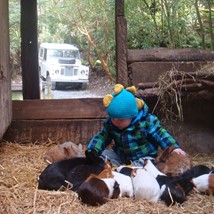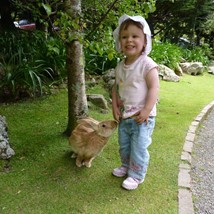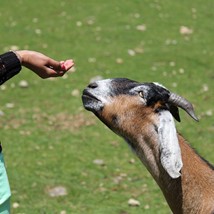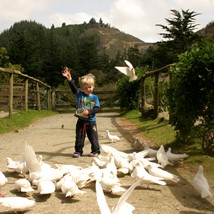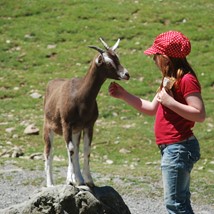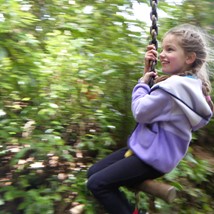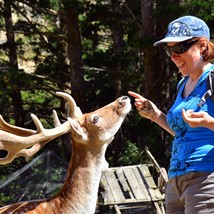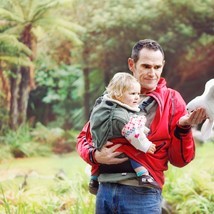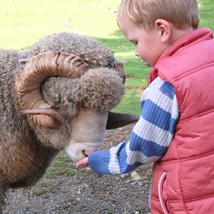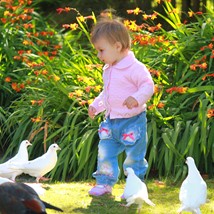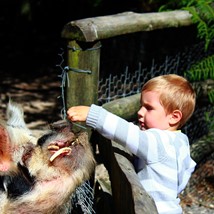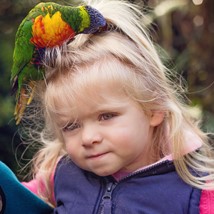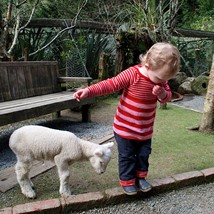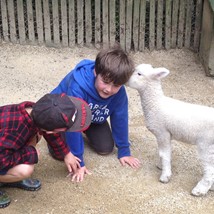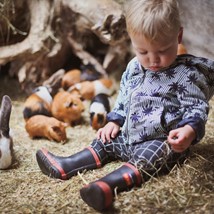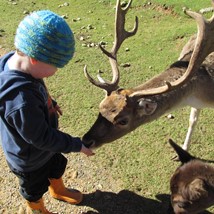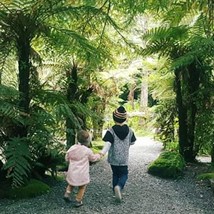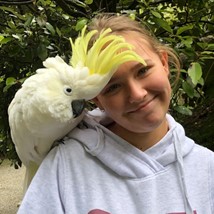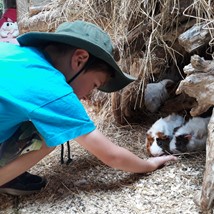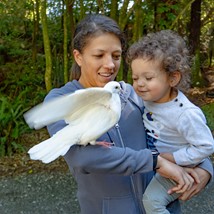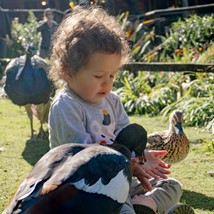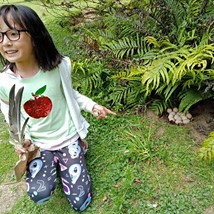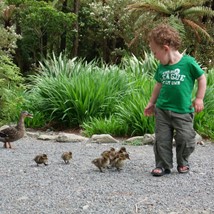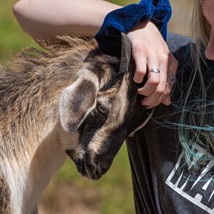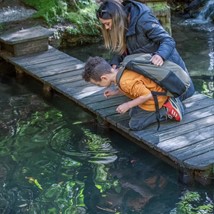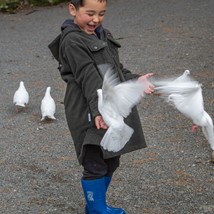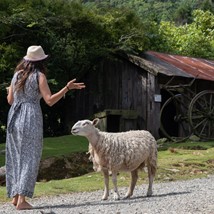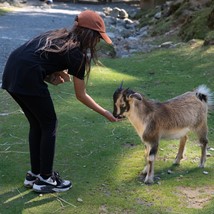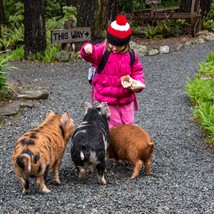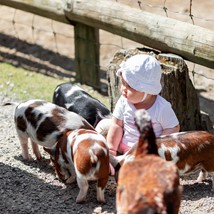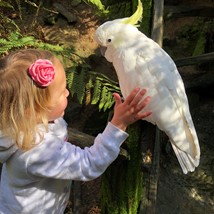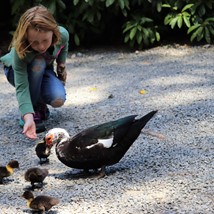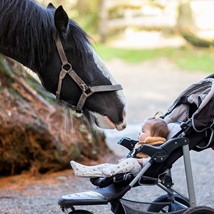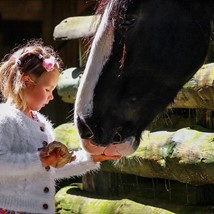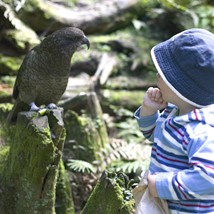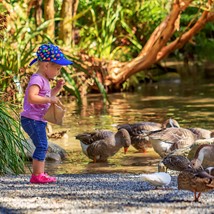Our Story
"It is my belief that an enormously rewarding and lifelong appreciation of wildlife can be kindled by a brief, intense encounter with an animal or a bird….
Staglands is my attempt to provide that encounter in an environment that is as good as I can possibly make it"
- John Simister
Staglands Wildlife Reserve was established by John Simister in 1972 in the beautiful Akatarawa Valley near Wellington.
John grew up in rural England and as a boy loved to be alone in the woods and fells, watching animal and birdlife. He yearned for wide open sky and a world where birds and animals lived freely in their natural habitat.
The Reserve had its beginnings in this childhood long before it became a reality.
Its creation involved the steady and meticulous re-cycling and sculpting of 25 acres of bush, farmland, water and thousands of tonnes of clay into an idyllic natural home for unusual, iconic and endangered species.
John was uncompromising in his attention to the smallest detail.
That detail is the essence of Staglands and Johns skill, in creating a world that no one knows has been created, is a rare one indeed.
Since its inception, John has worked tirelessly alongside his partner, Sarah and their committed team, to ensure Staglands enduring appeal.
Read more about the story of Staglands here.
You can support us and get more involved by purchasing a Staglander Annual Pass.
Conservation at Staglands
We play a big part in Aotearoa NZ’s conservation efforts through our captive breeding program for whio.
One of the overall aims of Staglands is advocacy - by ensuring that all New Zealanders have access to their native wildlife, in as natural surroundings as possible.
By creating an interactive, memorable experience, our wildlife park hopes to inspire visitors to become more involved with the environment. The Reserve is home to several important native species and liaison with the Department of Conservation ensures their long term survival.
Certain wildlife reserves, zoos and individuals around New Zealand are permitted by the Department of Conservation to hold native birds and animals, the aim of these are to provide:
- Animals for release to the wild
- An “insurance” in case of a sudden decline of wild populations
- Animals for education and display to increase public appreciation and support for species conservation
- Develop and document husbandry techniques for the survival of the species
Endangered species are categorised by DOC using international standards of threat ratings from one to eight, with one being the most critical.
Rare Wildlife Breeds at Staglands
Kunekune Pigs
The exact origin of kunekune pigs is not known exactly. Some say that Māori brought them over in the first canoes that arrived in Aotearoa New Zealand, others say that they are Asian in origin.
The introduction of refrigeration (removing the need to preserve produce using fat), together with increased urbanisation and decreased fat consumption resulted in a drastic decline in their numbers. A rescue mission by Staglands Wildlife Reserve and Willowbank Wildlife Reserve to preserve the breed now sees them thriving.
Kunekune are a very docile pig; round, plump looking, short legged, and dumpy with an upturned nose. Most have the distinctive tassels (piripiri) hanging either side of their neck and they come in a wide range of colours.
Kunekune is a Māori word, and in English it means “fat and round”!
Click here to find out more about what you can do to help support Aotearoa New Zealand’s kunekune conservation efforts.
Auckland Island Pigs
The Auckland Islands are a group of sub-Antarctic islands, located 320kms south of Aotearoa New Zealand. Many animals were released on these islands in the 1800s with a view to feeding shipwrecked sailors, usually from sealing or whaling ships.
By the end of the last century the Department of Conservation decided that too much vegetation was being destroyed and that the eggs and young of ground nesting birds were at great risk. This resulted in the decision to substantially reduce all introduced animals on the island.
An expedition to save some of the pigs was carried out in 1999 by the Rare Breeds Society, some of which now reside at Staglands, Wellington.
These pigs are smaller than the average wild pig, with longer, narrower heads and noses and with a long, straight tail.
Our enclosure here at our Wellington farm park has an elevated walkway from where you can view the pigs roaming around in their bush setting.
Click here to find out more about what you can do to help support Aotearoa New Zealand’s Auckland Island pig conservation efforts.
Arapawa Island Goats
It is widely believed that Arapawa Island goats are a surviving remnant of the Old English breed, descended from a pair released by James Cook onto Arapawa Island in the Marlborough Sounds in 1773. These goats have never numbered more than a few hundred and were always subject to intermittent hunting. In the 1970s they were threatened with eradication as they were seriously damaging the island’s native forest so a programme of culling was instigated.
Fortunately, the dedicated efforts of one Arapawa Island resident, Betty Rowe, assisted by her family and volunteer helpers, thwarted the efforts of the cull team, with the result that a small but viable population of Arapawa goats was saved.
In the mid 1970’s Staglands was first involved in removing some goats from the Island to help preserve the breed. In recent years more been removed and are now being bred by a few enthusiasts in various places throughout NZ, the USA and UK. However, the total number in domestication worldwide is still thought to be less than three hundred and according to the American Livestock Breeds Conservancy, the Arapawa Island goat is one of the rarest goat breeds in the world and critically close to extinction.
With their priority being the protection of the native fauna and flora on Arapawa Island's reserve, an annual cull of the goats by DOC continues today. This inspired a 2013 initiative by the NZ Arapawa Goat Association, DOC and Staglands to capture and remove some goats from the Island.
Our aim is to work towards successfully breeding Arapawa Island goats and encourage others to do the same to help maintain this rare breed.
Click here to find out more about what you can do to help support Aotearoa New Zealand’s Arapawa Island goat conservation efforts.
Our Tiaki Promise
Caring for People, Place and Culture
Aotearoa New Zealand is precious, and everyone who lives and travels here has a responsibility to look after it. Tiaki means to care for people, place and culture, for now and for future generations.
By following the Tiaki Promise, we are making a commitment to act as a guardian, protecting and preserving our home.
At Staglands we are committed to practices that minimize our impact on nature and relentlessly pursue initiatives to better care for wildlife and the environment. In doing so we aim to inspire a lifelong appreciation of te taiao (the natural world).
Learn more about how you can commit to the #tiakipromise here
Sustainability at Staglands
Our Commitment to Sustainability
We offer our visitors a fun, interactive experience with nature in beautiful natural surroundings. By doing so, we hope to inspire in a love of wildlife and an understanding of the need to protect our natural environment.
We are committed to sustainable practices that minimize the impact on nature and relentlessly pursue initiatives to better care for wildlife and the environment.
These principles are reflected in all aspects of our business.
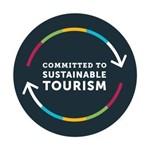
Staglands Conservation Involvement
- We plant a couple of thousand native plants and ferns every year.
- We participate in captive breeding programs of Aotearoa New Zealand native birds together with the Department of Conservation
- We run breeding programs for New Zealand heritage breeds in partnership with other parks and individuals.
- We implement predator control program.
- We participate in advocacy campaigns such as Whio Awareness Month to educate our visitors more about their importance to Aotearoa New Zealand and how we can help protect these nationally vulnerable species.
Environmental initiatives in practice
- We reduce, reuse, and recycle
- We choose eco-friendly products and packaging
- We purchase second-hand items
- We manage special or hazardous waste responsibly
- We purchase goods in bulk and source them locally to minimize carbon footprint
- We use energy-efficient lighting and appliances
- We have an electric vehicle charger available for visitors to use free of charge
- We use sustainable building techniques and technologies
- We manage and supply our own infrastructure (water supply and sewage)
- We install water-saving fixtures and devices
Become a conservation champion.
Subscribe to our newsletter, The Stag Rag to receive conservation tips and read our latest news. You can also get updates through our Facebook page and Instagram.
Get Involved
You can support us and get more involved by purchasing a Staglander Annual Pass
Enjoy unlimited visits to your favourite wildlife reserve, as often as you like, whenever you like, for 12 months.
Click here to find out more about the benefits of annual membership.
To purchase a Staglander Pass via our website please click here
Adult Staglander Pass $75.00
Child Staglander Pass $35.00 (3 years and under no charge - therefore pass not required)
Child Flexi Pass $115.00 (valid for named child plus any one adult)
Family Staglander Pass $220.00 (valid for 2 adults & 3 children)
We can also process orders on the phone by calling us on 04 526 7529 or via our contact us page.
Staglander Terms and Conditions